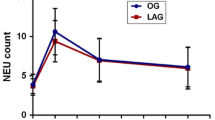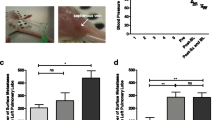Abstract
Abdominal operations induce immunosuppression during the time when tumors are manipulated and tumor cells are released into the circulation. The authors tested the hypothesis that the combined effect of these factors may promote the development of metastatic tumor implants and that perioperative treatment with Human Recombinant Interleukin-2 (RIL-2), a known immunostimulant oft, natural killer (NK), and lymphokine activated killer (LAK) cells may reduce the incidence of liver metastases from transplantable rat colon cancers. Hepatic metastases were induced in male Fischer 344 (F344) rats by injecting 107 rat colon tumor cells into the portal venous system during laparotomy. Control rats developed tumors by four weeks and were dead by ten weeks. Eleven groups of rats underwent celiotomy with portal vein injection of tumor on day three. Rats received either no RIL-2, RIL-2, or excipient buffer at varying doses on days 1 through 5 or 3 through 7 of these experiments. Animals were assessed for the presence of tumor and the incidence of liver metastases at autopsy (sacrifice and autopsy performed at seven weeks). Eighty-five percent of the rats in the untreated group developed tumor. This compared with only 50 percent of animals receiving 103 u/dose (P<.025) and 42 percent of animals receiving 104 u/dose (P<.01) of Interleukin-2 on days 1 through 5. Animals receiving very high doses of RIL-2 (105 or 4×105 units per dose) had a greater chance of developing tumors than did control rats, or rats receiving lower doses of RIL-2 (P<.05). It is concluded that the perioperative period may be critical for the implantation and growth of metastatic disease and that perioperative immunostimulation with RIL-2 can decrease the incidence of tumors in these animals. This model may have relevance to the treatment of human colon cancer.
Similar content being viewed by others
References
Roth JA, Golub SH, Grimm EA, Eilber FR, Morton DL. Effects of operation on immune response in cancer patients: sequential evaluation ofin vitro lymphocyte function. Surgery 1976;79:46–51.
Lundy J. The biologic dual effects of anesthesia and surgical treatment in the patient with cancer (editorial). Surg Gynecol Obstet 1979;149:245.
Bauer AR Jr, McNeil C, Trentelman E, Swift SA, Mason JD. The depression of T lymphocytes after trauma. Am J Surg 1976;136:674–80.
Cochran AJ, Spilg WG, Mackie RM, Thomas CE. Postoperative depression of tumour-directed cell-mediated immunity in patients with malignant disease. Br Med J [Clin Res] 1972;4:67–70.
Hunt PS, Trotter S. Lymphocyte response after surgery and blood transfusion. J Surg Res 1976;21:57–61.
Kinnaert P, Mahieu A, Mahieu M, Van Geertruyden N. Effect of surgical trauma on delayed type hypersensitivity. J Surg Res 1983;34:227–30.
Park S, Brody JI, Wallace HA, Blakemore WS. Immunosuppressive effect of surgery. Lancet 1971;1:53–5.
Slade MS, Simmons RL, Yunis E, Greenberg LJ. Immunodepression after major surgery in normal patients. Surgery 1975;78:363–72.
Tarpley JL, Twomey PL, Catalona WJ, Chretien PB. Suppression of cellular immunity by anesthesia and operation. J Surg Res 1977;22:195–201.
Fielding LP, Wells BW. Survival after primary and after staged resection for large bowel obstruction caused by cancer. Br J Surg 1974;61:16–8.
Weese JL, Ottery FD, Emoto SE. Do operations facilitate tumor growth? An experimental model in rats. Surgery 1986;100:273–7.
Weese JL, Gilbertson EM, Syrjala SE, Starling JR. Prevention of rat colon cancer metastases by perioperative immunostimulation. Surgery 1984;96:420–6.
Weese JL, Gilbertson EM, Syrjala SE, Whitney PD, Starling JR. Reduced incidence of rat colon cancer metastases by perioperative immunostimulation with maleic anhydride divinyl ether-2 (MVE-2). Dis Colon Rectum 1985;28:217–21.
Mulé JJ, Shu S, Schwarz SL, Rosenberg SA. Adoptive immunotherapy of established pulmonary metastases with LAK cells and recombinant interleukin-2. Science 1984;225:1487–9.
Steller EP, Ottow RT, Matthews W, Sugarbaker PH, Rosenberg SA. Recombinant interleukin-2 and adoptively transferred lymphokine-activated killer cells in the treatment of experimental peritoneal carcinomatosis. Surg Forum 1985;36:390–2.
Lafreniere R, Rosenberg SA. Successful therapy of hepatic metastases from several murine tumors using lymphokine-activated killer cells and recombinant interleukin-2. Surg Forum 1985;36:392–4.
Ettinghausen SE, Mulé JJ, Rosenberg SA. Immunotherapy of lung micrometastases from a murine sarcoma with recombinant interleukin-2: mechanism of action. Surg Forum 1985;36:394–6.
Hanna N. Inhibition of experimental tumor metastasis by selective activation of natural killer cells. Cancer Res 1982;42:1337–42.
Ward JM, Yamamoto RS, Weisburger JH, Benjamin T. Brief communication: transplantation of chemically induced metastatic mucinous adenocarcinomas of the jejunum and colon in rats. JNCI 1973;51:1997–9.
Reynolds CW, Timonen T, Herberman RB. Natural killer (NK) cell activity in the rat. I. Isolation and characterization of the effector cells. J Immunol 1981;127:282–7.
Timonen T, Reynolds CW, Ortaldo JR, Herberman RB. Isolation of human and rat natural killer cells. J Immunol Methods 1982;51:269–77.
Sondel PM, Hank JA, Kohler PC, Chen BP, Minkoff DZ, Molenda JA. Destruction of autologous human lymphocytes by interleukin 2-activated cytotoxic cells. J Immunol 1986;137:502–11.
Snedecor GW, Cochran WG. Statistical methods. Ames. IA: Iowa State University Press, 1980:125–8.
Fisher RA. Statistical methods for research workers. London: Oliver & Boyd, 1936;section 21:2.
Author information
Authors and Affiliations
Additional information
Supported by grants from the Veterans Administration, University Surgical Associates, American Cancer Society Grant CH-237B and NIH Grant CA-32685-04. Dr. Sondel is a Scholar of the Leukemia Society of America.
About this article
Cite this article
Weese, J.L., Emoto, S.E. & Sondel, P.M. Reduced incidence of hepatic metastases by perioperative treatment with recombinant human interleukin-2. Dis Colon Rectum 30, 503–507 (1987). https://doi.org/10.1007/BF02554778
Received:
Issue Date:
DOI: https://doi.org/10.1007/BF02554778




